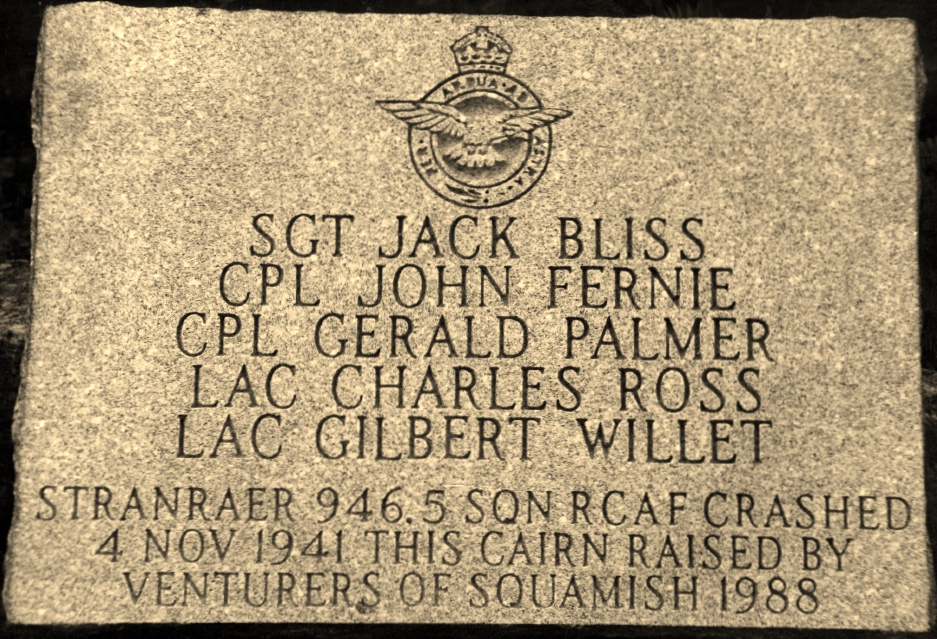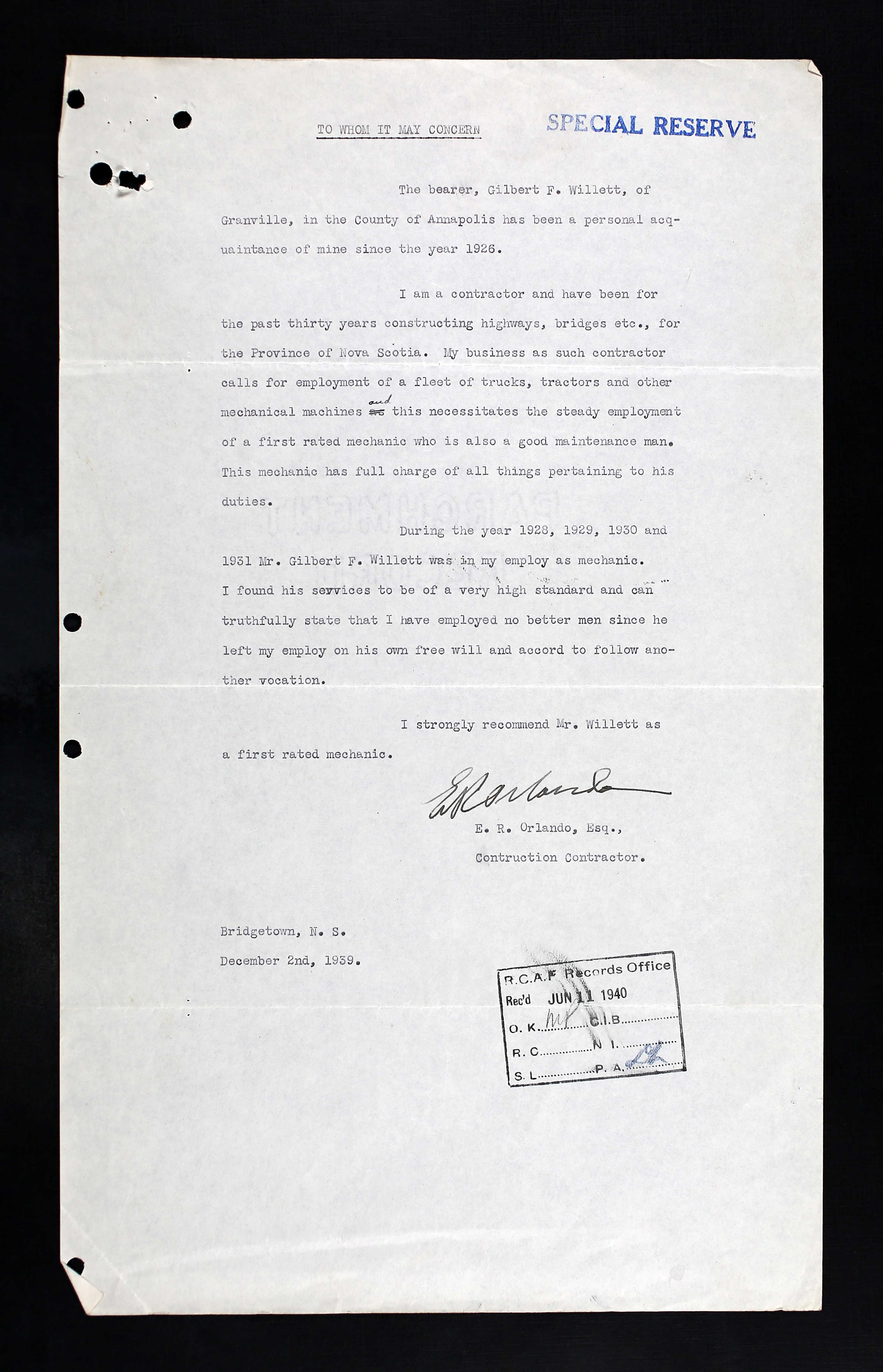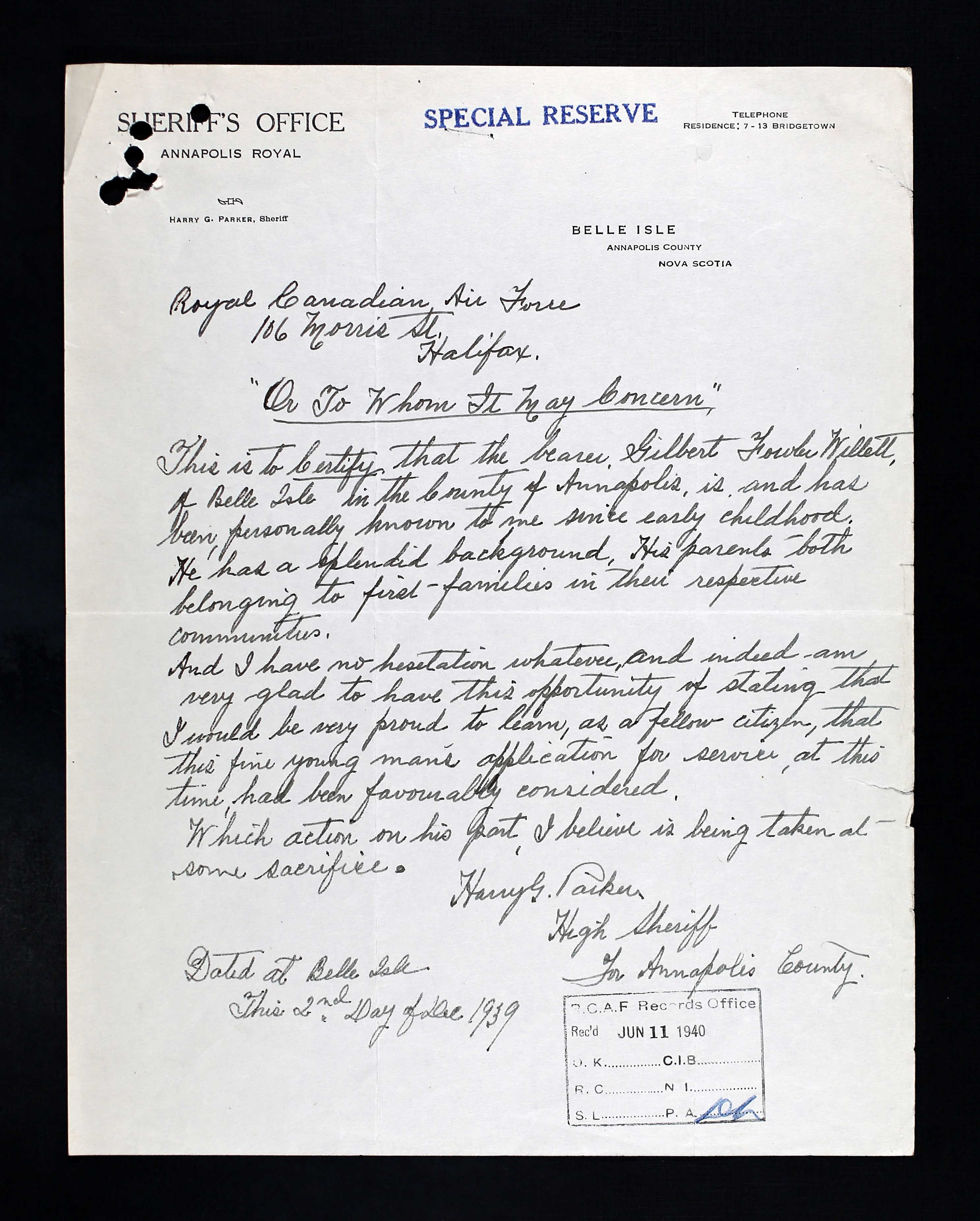



November 12, 1903 - November 4, 1941




Gilbert Fowler Willett, born in Granville Centre, Nova Scotia, was the son of Norman Freeman Willett (1869-1930) and Hester Lillian (nee Schaffner/Shafner) Willett (1874-?). He had one sister, Barbara May Morrison of Hampton, New Brunswick. The family was Anglican. Gilbert was named after his maternal grandfather.
He had a Grade IX education. Gilbert took a course through the American Tech Society (automobile engineering). He was an auto mechanic for others and then working for himself; then he did some farming before he enlisted with the RCAF in May 1940 in Halifax. He hoped to return to auto mechanics in his hometown after the war.
Gilbert married Florence Estelle Kearns (1903-1999) on September 17, 1930 in Granville Centre, Nova Scotia. They had three daughters, Carolyn Christena, born September 12, 1931, Lillian Elaine, born February 11 ,1935, and Doreen Estelle, born September 4, 1936. They continued to reside in Annapolis County, Nova Scotia. They owned some property there.
He liked to play softball and baseball occasionally. He felt his motor mechanical skills would benefit the RCAF. The RCAF accepted him as an aeroengine mechanic. “Wiry. Intelligent, keen. Good, neat appearance. Scar at the base of right thumb.” He stood 5’8” tall and weighed 136 pounds. He had brown eyes and dark hair. He had upper dentures and was missing his lower molars. He smoked a pipe from time to time. “Fairly good responses. Pulses and fatigue test are satisfactory. Physique is not impressive. Examinee is underweight. Muscle tone is only fair.”
Gilbert travelled west to Toronto and No. 1 Manning Depot, June 1, 1940 then was sent to TTS St. Thomas, June 28th. He was then sent to No. 5 Squadron, Dartmouth by October 20, 1940 where he remained in service until November 4, 1941.
He was in hospital on November 29, 1940 and then again from March 24 to 27, 1941. He had conjunctivitis once or twice while with the RCAF. In July 1941: “Fair physique. Condition of teeth is under required number of points. These can be attended to.”
On November 4, 1941, Stranraer 946 was lost as the airplane and crew headed towards the BC coast from a stop at Penticton, BC hitting a snowstorm.
Crew: *Bliss, Jack Fenton, Sergeant, R58599, *Palmer, Gerald Searing, Sergeant, C4216 *Fernie, John Robert Bruce, Corporal, R50490 *Ross, Charles Murray, Leading Aircraftman, R65863 *Willett, Gilbert Fowler, Leading Aircraftman, R65048
On November 25, 1941, a letter, written by G/C F. V. Heakes for Chief of the Air Staff was sent to families of the men aboard Stranraer 946. “It is with deep regret that we have to advise you in reply to your letter of November 18, 1941, that the Stranraer aircraft in which your son…was lost while en route from Penticton BC to Patricia Bay, Vancouver Island, British Columbia is still missing…the journey on which the aircraft was lost was a very short one, particularly as the longest and most difficult part of the trip was from Ottawa had already been completed. The aircraft was in radio communication with the range to Hope British Columbia but lost communication at about that point. It was apparently later seen over Vancouver Island, only a short distance northwest of its final destination. During the time the aircraft was en route from Penticton, the weather on the coast had badly deteriorated and visibility had become very poor. For this reason, other aircraft of this type had returned to base and it would seem fairly certain that the aircraft seen was the one which is missing.
The aircraft carried fuel for a minimum range of 600 miles and for this reason search for it has proceeded a distance of several 100 miles up and down the British Columbia coast, all of the inlets and inland waterways and out to sea. Additionally, the search has covered the mainland, Vancouver Island, and the northern inland region of the United States. Not only have our own aircraft searched but the United States Air Service has have also assisted by having their aircraft cover wide areas for us. Naval vessels have also collaborated in the search. The search is still being conducted and every rumor is being followed up in the hope a successful end might be made to our efforts. The aircraft was new and in perfect condition, while the pilot was experienced on this type and had flown at operationally on the coast. Aviation has unhappily always presented those engaged in it with problems of this kind, and while every effort and precaution is exercised to ensure safety of personnel and aircraft, these efforts sometimes fail. Where they do fail, as in this case, it is natural that relatives of men missing should feel concerned as they ordinarily have little knowledge of the organization that exists to ensure safety of aircraft and to render aid when necessary. You may be reassured that no effort to discover this last aircraft has been or will be spared.”
In October 1947, the plane was located by prospector Basil Zurbriggen. [Interestingly, he had been considered missing in September 1947.]
Jerry Vernon, CAHS Vancouver Chapter President wrote on the RAF Commands Forum in 2011 indicating that a cairn was built at the site, approximately ten miles southeast of Squamish, British Columbia. The airplane flew into the hillside at the end of Indian Arm between Indian Arm and Squamish. “Any logging roads into the site were washed out long ago. The aircraft just caught the top of the ridge, otherwise they would have been over the top and looking at Howe Sound in the distance. There is a wooden cross at the crash site with the names of the crew, but vandals had partially burned it.” Details: “Reading some of the detail on 946....it had left RCAF Stn. Rockcliffe on 07 Oct 41. There was a change of pilot at Regina on 18 Oct 41, when F/O Coburn came down with acute appendicitis. Sgt. Jack Bliss took over as pilot. They landed at Brooks, Alberta, on 21 Oct 41 and bought gas from the Brooks Garage. One wingtip was damaged on the end of the CPR pier at Penticton on 23 Oct 41, and this took 12 days to repair. The aircraft departed from Okanagan Lake in poor weather on 04 Nov 41. At 1300 hrs, the aircraft reported that they were ‘SE of Vancouver in the North Sector of the Princeton Range, flying blind and descending to try and make contact with the ground.’ They were advised to remain at 11,000 ft. until they had crossed the Vancouver cone marker. At 1346, the last radio messages from the aircraft said that ‘We are lost in a dense snowstorm over land and are nearly out of fuel. No position can be decided.’ A large scale search was conducted, particularly in the Port Alberni and Mount Arrowsmith areas [Vancouver Island], as an aircraft had been heard in that vicinity. The search was discontinued on 27 Nov 41. The plane was found in heavy timber on 06 Oct 47 by an old trapper by the name of Zurbriggen. A cairn was erected, and a memorial service was held for the five lost airmen.”
In late October 1955, families received a letter from W/C W. R. Gunn, RCAF Casualties Officer, for Chief of the Air Staff who indicated that their sons did not have a known grave and their names would appear on the Ottawa Memorial.
Gilbert is remembered on his wife’s gravestone in Belle Isle, Annapolis County, Nova Scotia.
In the spring of 1986, the Hellcat Venture Company erected a monument to replace the deteriorated cross. Money was raised to place a memorial plaque in 1988. In 2012, a book was published to commemorate the men lost aboard Stranraer 946. See links below.
LINKS: